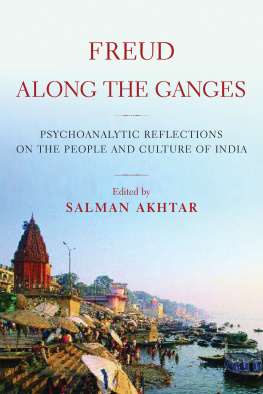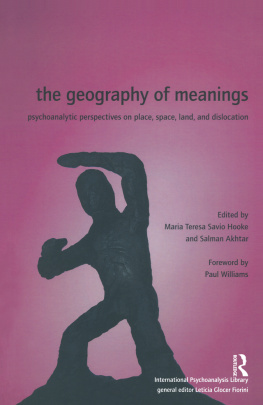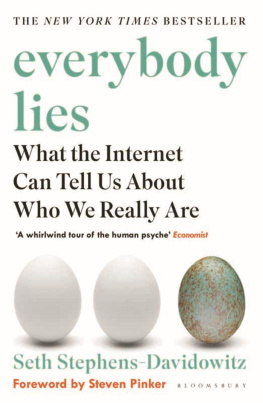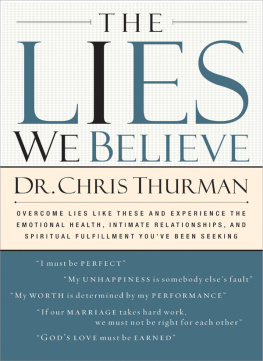About the Editors and Contributors
About the Editors and Contributors
Salman Akhtar, M.D., professor of psychiatry, Jefferson Medical College; training and supervising analyst, Psychoanalytic Center of Philadelphia, Philadelphia, PA.
Harold P. Blum, M.D., clinical professor of psychiatry, New York University School of Medicine; training and supervising analyst, New York University Psychoanalytic Institute, New York, NY.
Gail A. Edelsohn, M.D., M.S.P.H., associate medical director, Childrens Services, Department of Behavioral Health and Mental Retardation, Philadelphia, PA.
Ruth M.S. Fischer, M.D., clinical professor of psychiatry, University of Pennsylvania School of Medicine; training and supervising analyst, Psychoanalytic Center of Philadelphia, Philadelphia, PA.
Daniel M.A. Freeman, M.D., faculty member, Psychoanalytic Center of Philadelphia, Philadelphia, PA.
Lucy LaFarge, M.D., clinical associate professor of psychiatry, Weil Cornell Medical School; training and supervising analyst, Columbia University Psychoanalytic Center, New York, NY.
Mark Moore, Ph.D., director of psychological services, Joan Karnell Cancer Center, Pennsylvania Hospital, Philadelphia, PA.
Henri Parens, M.D., professor of psychiatry, Jefferson Medical College; training and supervising analyst, Psychoanalytic Center of Philadelphia, Philadelphia, PA.
Michael H. Stone, M.D., professor of clinical psychiatry, Columbia College of Physicians and Surgeons, New York, NY.
Clarence Watson, J.D., M.D., clinical director of forensic services, Delaware Psychiatric Center, New Castle, Delaware; assistant professor of psychiatry, Department of Psychiatry, Jefferson Medical College.
Acknowledgments
The chapters in this book, with the exception of chapters 1, 7, 9, and 10 were originally presented as papers at the 39th Annual Margaret S. Mahler Symposium on Child Development held on April 27, 2008. First and foremost, therefore, we wish to express our gratitude to the Department of Psychiatry of the Jefferson Medical College, the main sponsor of this event. We are especially indebted to Drs. Michael Vergare, chairman of the Department of Psychiatry and Human Behavior of the Jefferson Medical College, Bernard Freidberg, president of the Psychoanalytic Foundation of The Psychoanalytic Center of Philadelphia, and William Singletary, the president of the Margaret S. Mahler Foundation for their kind support of the Symposium. Finally, we wish to acknowledge our sincere appreciation of Ms. Melissa Nevin for her efficient organization of the symposium and for her skillful assistance in the preparation of this books manuscript.
CHAPTER ONE
Lies, Liars, And Lying: An Introductory Overview
Salman Akhtar, M.D.
Never lie in writing
(Mason Cooley, 1992)
Borrowing a phrase from the former vice president and recent Nobel Prize winner, Al Gore, I wish to begin this discourse on lying with some inconvenient truths. Here they are:
- Everyone lies.
- Anyone who claims to be forever truthful is telling a lie.
- It is undesirable to be truthful under all circumstances.
- Lying is essential for the smooth social dialogue and interpersonal politeness.
- Different forms and varying extents of lying are integral to many socially useful lines of work.
- Lying can at times save lives.
- Since all sorts of gray areas exist between what constitutes a lie and what constitutes a truth, it is not always easy to separate the two out.
It is only with the psychic ruthlessness of this backdrop that one can approach the matter of lying, cheating, and dishonesty with any modicum of seriousness. Such discussion must at its outset, address the formal characteristics of lies and the dynamic issues that propel a lie.
In the passages that follow, I will take up these issues one by one. Then I will make a brief foray into the world of forgery involving arts and antiques. Following this sociocultural digression, I will return to the clinical realm and address the implications of lying for conducting psychotherapy and psychoanalysis. I will conclude with a few synthesizing remarks.
The Structure of a Lie
In order to grasp the various formal characteristics of a lie, it might not be out of place to begin with a simple dictionary definition. A lie, according to Websters Ninth Collegiate Dictionary (1987) is an untrue statement with intent to deceive (p. 689). Also included in the explanatory comments that follow the initial crisp definition are phrases like an assertion of something known or believed by the speaker to be untrue and the deliberate creation of a false or misleading impression (p. 689). Pooling these tidbits with the notion of lying implicit in the well-known judicial instruction to tell the truth, the whole truth, and nothing but the truth leads one to the idea that a lie can be told in many ways. Lying is a multifaceted sport with diverse moves available to the deft player. Some prominent forms of lying are:
- Not telling the truth. Remaining silent while being asked to respond to a question, the answer to which one actually knows, constitutes a lie.
- Replacing the facts one knows to be true by false and misleading information
- Telling the truth but not the whole truth and, by such withholding of parts of relevant information, altering the inference to be drawn from ones report.
- Telling the truth but embellishing it in a way that results in a caricature and thus puts its veracity in question. The mechanism of denial by exaggeration (Fenichel, 1945) belongs in this category.
- Flatly and forcefully questioning and even repudiating an established truth. The phenomenon of gas lighting (Barton and Whitehead, 1969) where one individual seeks to drive someone crazy by stirring up doubts about the latters perception is an example of this type of lying. Instances of soul murder (Shengold, 1989) where a childs perception is ruthlessly erased by cruel and abusive parent, and the denial of the Holocaust are other examples from individual and collective arenas, respectively, of this very type of lie.
- Acknowledging the truth about a certain matter but retrospectively imputing motives to it that were not in operation earlier. The ego operation of sliding of meanings (Horowitz, 1975) seen in narcissistic personalities is an example par excellence of such a strategy.
What all this demonstrates is that lies come in many forms. From bald-faced assertions of falsehood to subtle distortions or reality, lies elude simplistic nosological traps. To discern them, one not only requires to pay close attention to what is being said and why but also to what is not being said, what is being exaggerated, what is being minimized, and what is being painted with a revisionist brush. One also has to take into consideration the intrapsychic and interpersonal context in which a lie is being constructed and conveyed; lying invariably involves a self-object scenario, however deeply buried under narcissistic grounds that might be. And, this brings up the consideration of the motivational dynamics behind lying.
Motivation for Lying
Like all human behavior, lying is multiply-determined (Waelder, 1936). Each lie involves instinctual pressures, narcissistic interests, superego defects, and ego loopholes. Each lie is a cavern of a wishful fantasy and an attempt to ward off a dreaded imaginary scenario. Each lie constitutes a psychic maneuver to alter the self-object relations; the object involved might be a specific human being or a diffuse world of people and institutions. Each lie has origins and consequences both within the subjects psyche and his or her interpersonal surround. Each lie creates something and destroys something. Being opposed to truth, each lie, to a greater or lesser extent, attacks, or at least bypasses, the great realities of separateness, finiteness, and the ubiquitous nature of aggression, genital differences, and incest barrier.
















